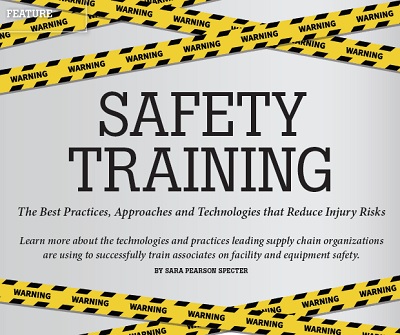The Best Practices, Approaches and Technologies that Reduce Injury Risks

BY SARA PEARSON SPECTER
“Safety first.” It’s something all supply chain organizations strive for, yet some facilities have better safety records than others. According to the Bureau of Labor and Statistics, annual warehouse fatalities doubled—from 11 to 22—in 24 months between 2015 and 2017. Further, the warehouse injury rate is 1.5 per 100 full-time associates.
What techniques, then, are certain companies using to train their workers on facility and equipment safety more successfully, particularly in warehousing and distribution centers? There are a number of best practices, including approaches and technologies, that increase the effectiveness of safety training and subsequent compliance. Here, four safety training experts share strategies that help reduce the risk of on-the-job injuries and fatalities.
EFFECTIVE TRAINING TIPS
The most effective training is designed following a systematic process called the ADDIE method, which stands for analyze, design, develop, implement and evaluate, said warehouse safety and health expert Camille Oakes, president of Camille Oakes Consulting.
“To apply this method, an organization needs to ask themselves a series of questions, such as: Why do we need this training? What’s the best method to deliver it? Should it be in-person or computer-based?” she explained, noting that during this analysis phase, organizations should conduct a training needs assessment.
That’s because training is often conducted after an accident has occurred—yet, a lack of training might not have been the cause. “Perhaps there was training, but it was good, or it was bad,” she said. “Maybe training won’t solve the problem, but a physical modification to the process or equipment would. If you don’t know the answer, then your training won’t be effective.”
Further, understanding the learning objectives is important when designing the training, said Oakes: “You should only be doing training when you know what issue it is going to solve. How is the job performed? What does a trainee need to know from the session? Do they really need to know the OSHA regulations they need to comply with, or just that they need to use a pre-inspection checklist prior to operating a forklift, for example?”
A standardized evaluation method should also be included as part of the training process in order to determine its effectiveness. Oakes recommended conducting pre- and post-training tests to assess what trainees learned from the session, as well as analyzing metrics to see if there is a reduction in incidents—such as near misses or policy deviations—after the training is complete.
 MHI Solutions Improving Supply Chain Performance
MHI Solutions Improving Supply Chain Performance